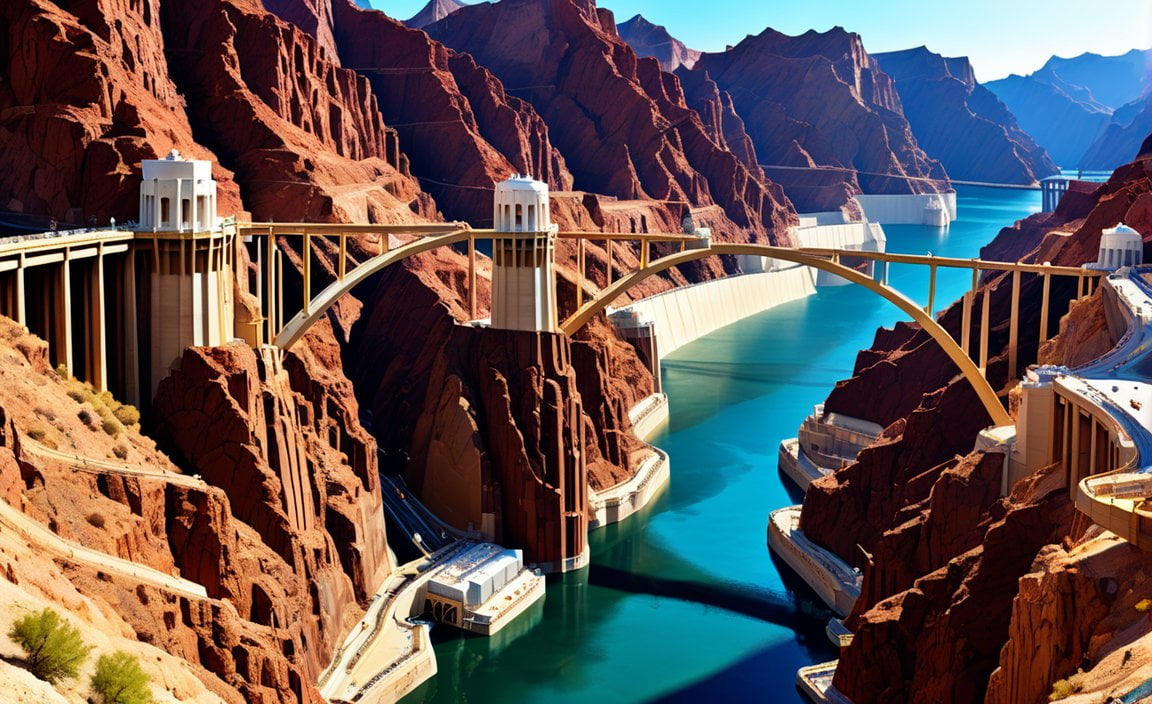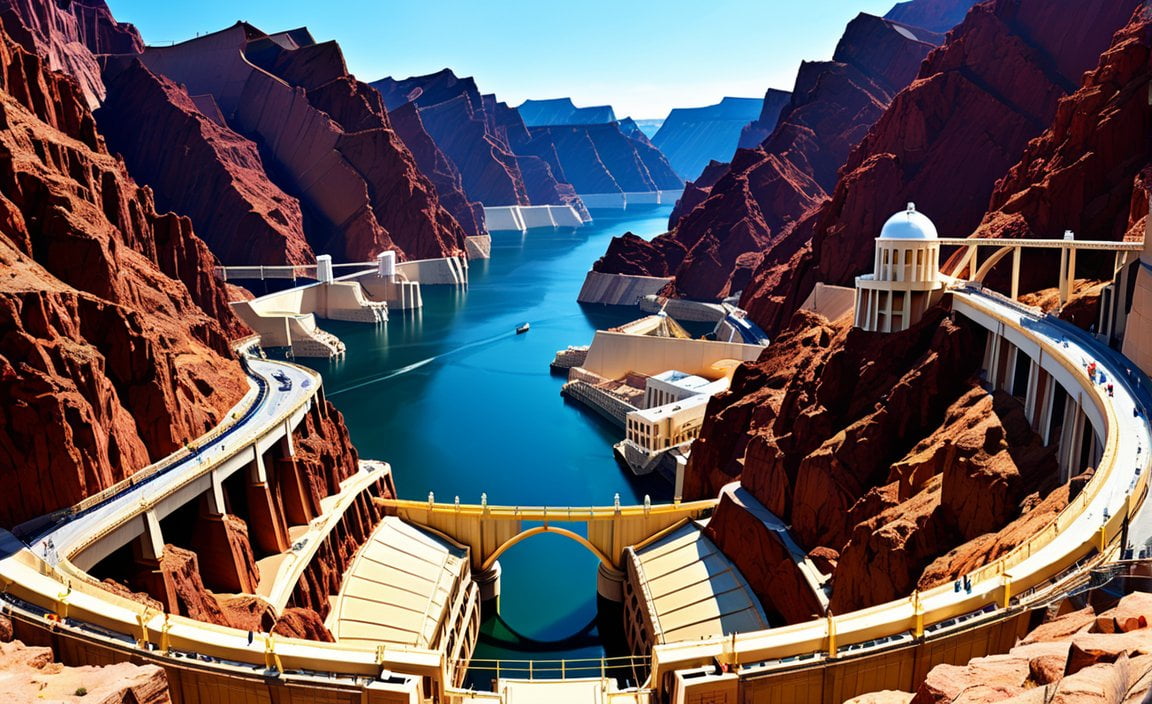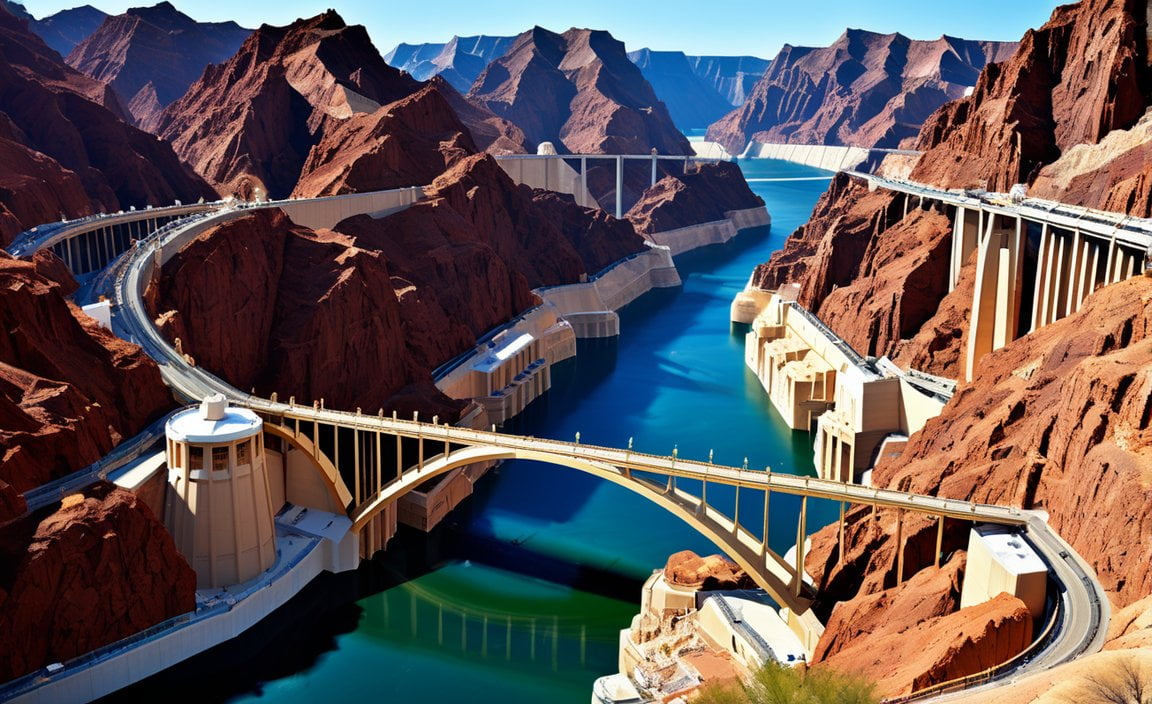Welcome to “Fascinating Fun Facts: Exploring Hoover Dam’s Wonders,” where we delve into the remarkable world of one of America’s most iconic structures. Join us as we uncover the lesser-known facts and awe-inspiring details about the Hoover Dam. From its astounding engineering feats to its historical significance, this article is packed with captivating insights that will leave you spellbound. Get ready to embark on an exciting journey through the incredible wonders of Hoover Dam!

Key Takeaways:
- The Hoover Dam, completed in 1935, is considered the Greatest Dam in the world and was the tallest dam at the time of its construction.
- The dam stands at 726 feet tall and is 1,244 feet long, making it an impressive engineering feat.
- The base of the dam is as thick as two football fields and is made of materials that could construct two football fields.
- Situated on the border of Nevada and Arizona, the dam is named after President Herbert Hoover, who was in office when the idea of building the dam began.
- It took five years to complete the construction of the dam, with a total cost of $49 million.
- The dam impounds the Colorado River, creating Lake Mead, the largest reservoir in the United States.
- Lake Mead provides flood control, irrigation, water supply, and hydroelectric power.
- The dam generates up to 2,080 megawatts of electricity, serving millions of homes in Nevada, Arizona, and California.
- The Hoover Dam is a National Historic Landmark and attracts approximately 7 million visitors and 1 million tours annually.
Fun facts Hoover Dam
The Hoover Dam, also known as the Greatest Dam in the world, is an engineering marvel that has captivated people for decades. Let’s dive into some fascinating fun facts about this iconic structure:
A Tall Wonder
- Did you know that the height of the Hoover Dam is equivalent to a towering structure with 60 stories? Standing at an impressive 726 feet, it is truly a remarkable sight to behold.
A Massive Base
- The base of the dam is as thick as two football fields measured end-to-end. Just imagine the sheer amount of materials used to construct such a sturdy foundation!
Power and Water Galore
- The Hoover Dam is not only responsible for impounding the Colorado River to create Lake Mead, the largest reservoir in the United States, but it also serves multiple important functions. It provides flood control, irrigation, water supply, and produces hydroelectric power.
Electrifying Power
- Speaking of power, the dam generates up to 2,080 megawatts of electricity, which is used to serve millions of homes in Nevada, Arizona, and California. It’s incredible to think about the number of lives that are positively impacted by the energy generated here.
An Iconic Landmark
- Designated as a National Historic Landmark, the Hoover Dam is a symbol of human innovation and determination. It attracts approximately 7 million visitors and hosts 1 million tours annually, showcasing its enduring appeal.
If you want to learn even more intriguing facts about the Hoover Dam, be sure to visit coolkidfacts.com and usbr.gov.
So there you have it, some captivating fun facts about the Hoover Dam. It’s truly a testament to human engineering and a sight that should not be missed.
What is the state of Michigan known for? Check out this link for fascinating information about Michigan’s rich history and unique attractions: What is the state of Michigan known for.
Looking for the highest point in Arkansas? Click here to discover the breathtaking peak that offers stunning views of the state: What is the highest point in Arkansas.
Curious about random facts about Chile? Explore this link to uncover interesting tidbits about this captivating country: Random facts about Chile.
Have you ever wondered about the longest volleyball game ever played? Click here to find out about an epic match that pushed players to their limits: Longest volleyball game.
Where is volleyball most popular? Discover the vibrant locations where volleyball has captured the hearts of enthusiasts around the world: Where is volleyball most popular.
How many capitals has Honduras had over the years? Find out more about the historical journey of Honduras’ capital cities by clicking here: How many capitals has Honduras had.
In search of a comprehensive list of counties in the United States? Explore this link to access a detailed directory of all the counties across the nation: List of counties in the United States.
The Dam’s Purpose: Controlling Flooding, Generating Hydroelectric Power, and Providing Irrigation Water
The Hoover Dam, an engineering marvel, stands as a testament to human ingenuity. Completed in 1936, it was the tallest dam ever constructed at that time. One can only imagine the awe and wonder it must have inspired back then, and it continues to captivate visitors today.
But what was the purpose behind this monumental structure? The dam was built with several important objectives in mind – controlling flooding, generating hydroelectric power, and providing irrigation water. Let’s dive deeper into these fascinating aspects of the Hoover Dam.
Controlling Flooding
One of the primary reasons for constructing the Hoover Dam was to control the flow of water on the mighty Colorado River. In the past, seasonal flooding caused widespread damage, creating havoc for communities downstream. The dam’s immense size and strength allowed it to effectively regulate the river, minimizing the risk of devastating floods.
Generating Hydroelectric Power
Another remarkable feature of the Hoover Dam is its ability to generate hydroelectric power. That’s right, in addition to its flood control capabilities, the dam harnesses the power of flowing water to produce electricity. The rushing water spins enormous turbines, which, in turn, generate clean and renewable energy. This hydroelectric power facility has been operational for over 80 years, a testament to its technological excellence.
Providing Irrigation Water
Water is a precious resource, especially in arid regions like the Southwest United States. The Hoover Dam plays a crucial role in providing irrigation water to the surrounding areas. By controlling the flow of the river and storing water in the vast reservoir created behind the dam, known as Lake Mead, the dam ensures a steady supply of water for agricultural purposes. This water is instrumental in sustaining crops, helping farmers flourish in an otherwise challenging environment.
These three indispensable functions – flood control, hydroelectric power generation, and irrigation water supply – make the Hoover Dam an engineering marvel of unparalleled significance. Its construction not only tamed the powerful Colorado River but also brought positive change to the lives of countless people.
Visitors to the Hoover Dam have the opportunity to marvel at its architectural magnificence and learn about its captivating history and engineering marvels through guided tours. From understanding the intricate workings of the hydroelectric power turbines to witnessing the vast expanse of Lake Mead, the experience is truly awe-inspiring.
So, next time you’re planning a trip to the Southwest United States, be sure to add the Hoover Dam to your itinerary. It’s more than just a structure; it’s a testament to human achievement and a vital resource for controlling floods, generating renewable energy, and providing essential irrigation water.
Fascinating Fun Facts: Exploring Hoover Dam’s Wonders
The Hoover Dam stands at an impressive 726 feet tall and spans over 1,200 feet across the Black Canyon. It is an iconic structure located in the Black Canyon of the Colorado River, between Nevada and Arizona. Let’s dive into some fascinating facts about this architectural marvel.
Overview of Hoover Dam
Constructed during the Great Depression from 1931 to 1936, the Hoover Dam symbolizes the triumph of human ingenuity and engineering prowess. On September 30, 1935, President Franklin D. Roosevelt dedicated the dam, solidifying its place in history.
Hoover Dam’s Mind-Blowing Dimensions
- Reaching a staggering height of 726 feet, equivalent to a 60-story building, the Hoover Dam stands tall as a testament to human achievement.
- Spanning over 1,200 feet across the magnificent Black Canyon, the dam showcases both its grandeur and architectural brilliance.
- The base of the dam is an astounding 660 feet thick, providing the strength to withstand the powerful forces of the Colorado River.
- The retaining wall, a true feat of engineering, weighs a mind-boggling 6.6 million tons and required a staggering 91.8 billion cubic feet of concrete.
Powering the Southwest
Apart from its striking dimensions, the Hoover Dam serves a crucial role in harnessing renewable energy and supplying water to the Southwest region of the United States.
* Functioning as a hydroelectric power plant, the dam generates an impressive capacity of approximately 2,080 megawatts of power. This supplies sustainable electricity to millions of homes in Nevada, Arizona, and California.
* Moreover, the dam plays an essential role in providing water to the growing Southwest, contributing to agricultural irrigation, water supply, and flood control measures.
Impact on the Environment
While the Hoover Dam’s construction was an engineering marvel, it also had significant environmental consequences.
* The formation of Lake Mead, the largest reservoir in the United States, due to the Hoover Dam’s construction altered the natural flow of the Colorado River.
* This transformation led to the creation of the Lake Mead National Recreation Area but affected wildlife and ecosystems downstream, requiring careful conservation efforts.
Visiting Hoover Dam
Hoover Dam remains a top tourist destination, attracting nearly a million visitors annually. Exploring this remarkable structure offers an opportunity to learn about its rich history, design, and significance. Major highlights include:
* Guided tours that provide fascinating insights into the dam’s construction, its impact on the region, and the intricate workings of the hydroelectric power turbines.
* Visitors can marvel at the sweeping views of the Black Canyon and the vast expanse of Lake Mead, immersing themselves in the grandeur of this architectural masterpiece.
Key Takeaways:
– The Hoover Dam stands at an impressive 726 feet tall and spans over 1,200 feet across the Black Canyon.
– It is an iconic concrete arch-gravity dam located between Nevada and Arizona.
– The dam’s construction took place from 1931 to 1936 during the Great Depression and was dedicated on September 30, 1935, by President Franklin D. Roosevelt.
– The base of the dam is a remarkable 660 feet thick, and its retaining wall weighs an astonishing 6.6 million tons.
– Hoover Dam serves as a hydroelectric power plant, generating approximately 2,080 megawatts of power.
– The dam’s creation had significant environmental impacts, including the formation of Lake Mead and changes to wildlife and ecosystems downstream.
– Hoover Dam attracts nearly a million visitors annually, who can explore its history, design, and significance through guided tours.
Sources:
1. USA Today – Facts About Hoover Dam
2. Wikipedia – Hoover Dam
Fascinating Fun Facts: Exploring Hoover Dam’s Wonders
The construction of the Hoover Dam was a monumental feat, resulting in one of the largest concrete structures in the world. It’s truly awe-inspiring to think about the sheer amount of material that went into its creation. Are you ready to uncover some fascinating facts about the Hoover Dam and its impressive construction?
Key Takeaways:
- The Hoover Dam required over 5 million barrels of concrete, making it one of the largest concrete structures in the world.
- It was constructed during the 1920s and 1930s, under the presidency of Herbert Hoover.
- The dam’s purpose was to tame the Colorado River and provide water and electricity to the Southwest region of the United States, powering major cities like Los Angeles, Las Vegas, and Phoenix.
Now, let’s dive into the details!
- A Colossal Concrete Wonder:
This iconic structure required an astonishing amount of concrete to come to life. Over 5 million barrels, or approximately 4.36 million cubic meters, of concrete were used in the construction of the Hoover Dam. This massive quantity of concrete solidifies its place as one of the largest concrete structures globally, showcasing the incredible engineering prowess of its time. Each barrel represented another step toward turning this ambitious project into a reality.
[Citation: Bureau of Reclamation]
- A Symbol of Ingenuity and Progress:
The construction of the Hoover Dam took place during the challenging period of the Great Depression. As the American workforce faced hardship, this remarkable project provided hope and employment opportunities for thousands of eager laborers. More than 21,000 workers, armed with determination and skilled craftsmanship, came together to build this remarkable structure. It stands as a testament to human resilience and the spirit of progress that shone through even in the darkest times.
[Citation: HISTORY]
- A Lifeline for the Southwest Region:
Beyond its impressive stature, the Hoover Dam has fulfilled its intended purpose with great success. By harnessing the power of the Colorado River, it not only generates electricity but also provides essential water resources to the arid regions of the Southwest United States. The dam’s 17 turbines generate a staggering amount of power, capable of supporting approximately 1.3 million homes. It fulfills its role to this day, playing a vital role in fueling the growth and development of major cities like Los Angeles and Las Vegas.
[Citation: Bureau of Reclamation]
- A Historical Legacy:
The Hoover Dam remains an architectural marvel and a testament to the ingenuity of its time. Its colossal size and unique design have earned it recognition as a National Historic Landmark. Every year, it attracts millions of visitors who come to witness its grandeur firsthand and learn about its rich history. The dam’s guided tours offer in-depth insights into its engineering, captivating visitors with the tales of its construction and functionality.
[Citation: HISTORY]
As you explore the sweeping views and marvel at the engineering prowess on display, take a moment to appreciate the astounding fact that over 5 million barrels of concrete were poured to create the Hoover Dam. This enduring structure stands as a testament to human achievement, bringing together engineering excellence, historical significance, and the remarkable resilience of the American spirit.
Now, go out there and experience the wonders of the Hoover Dam for yourself!
Sources:
- Bureau of Reclamation. “Hoover Dam | Bureau of Reclamation.” Retrieved from www.usbr.gov/lc/hooverdam/history/essays/concrete.html.
- HISTORY. “Hoover Dam.” Retrieved from www.history.com/topics/great-depression/hoover-dam.

FAQ
Q1: How tall is the Hoover Dam?
A1: The Hoover Dam stands at a height of 726 feet, which is equivalent to a structure with 60 stories.
Q2: What is the width of the dam at its base?
A2: At its base, the Hoover Dam is as thick as two football fields measured end-to-end, with a width of 660 feet.
Q3: What does the Hoover Dam’s reservoir provide?
A3: The dam’s reservoir, Lake Mead, serves multiple purposes including flood control, irrigation, water supply, and generating hydroelectric power.
Q4: How much electricity does the Hoover Dam generate?
A4: The Hoover Dam generates up to 2,080 megawatts of electricity, which is enough to serve millions of homes in Nevada, Arizona, and California.
Q5: How many visitors does the Hoover Dam attract annually?
A5: The Hoover Dam attracts approximately 7 million visitors and hosts 1 million tours each year.
















